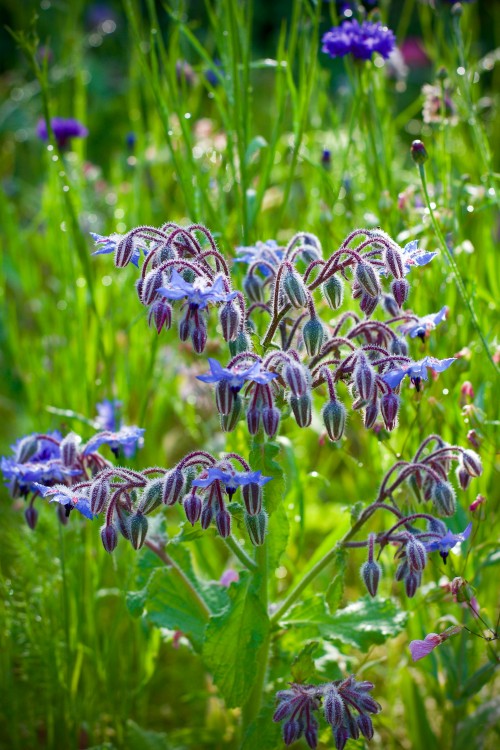Borage
A Complete Guide to growing borage in the UK
Introduction
Borage (Borago officinalis), often called the “starflower,” is a hardy annual herb valued for its striking blue flowers and cucumber-flavoured leaves. It’s a favourite among pollinators, particularly bees, and is also widely used in companion planting, herbal remedies, and summer drinks like Pimm’s. Easy to grow from seed and self-seeding year after year, borage is a rewarding crop for UK gardeners who want beauty, biodiversity, and usefulness in the garden.
Types and Timing
Borage is typically grown from seed, with the common blue-flowered variety being the most popular in the UK. There are also white-flowered cultivars, but these are less common.
Seeds can be sown directly outdoors from April to June once the soil has warmed. For an earlier start, seeds may be sown under cover in March. Because borage grows quickly and self-seeds readily, succession sowing is rarely necessary, though a late sowing in June can extend flowering into autumn.
Site and Soil Requirements
Borage thrives in full sun but will tolerate partial shade. It prefers well-drained soil, though it is not fussy and can cope with poor ground. Soil enriched with organic matter will produce healthier plants and more prolific flowers.
It is well suited to cottage gardens, herb borders, and wildlife areas, but can also be grown in large containers. Just be sure containers are deep, as borage develops a long taproot.
Propagation & Planting
Seeds can be sown directly outdoors where they are to grow. Rake the soil to a fine tilth and sow seeds 1-2cm deep, spacing them about 30cm apart.
If starting indoors, sow seeds in modules or pots in March and plant out once seedlings are 5-7cm tall, after hardening off. Take care when transplanting as the taproot dislikes disturbance.
Growing & Maintenance
Borage is low-maintenance once established. Water young plants regularly until they are established, then only in prolonged dry spells. No feeding is usually required, though a mulch of compost around the base can improve growth.
Weed around young plants to reduce competition. Taller plants may need staking in exposed sites, as they can reach up to 60-100cm tall.
Borage is generally pest- and disease-free, and its presence can even deter pests from neighbouring crops.
Harvest and Post-Harvest
Leaves can be harvested when young and tender, as older leaves develop prickly hairs. Use them fresh in salads, drinks, or as a garnish.
Flowers can be harvested throughout summer. Pick just before use for best flavour and appearance, or freeze in ice cubes for later use.
Borage leaves do not store well, but flowers can be dried or crystallised for decoration.
Troubleshooting & Pests
Borage is typically trouble-free. The main concern is self-seeding, as plants drop seed generously and may pop up around the garden in following years. If this is unwanted, deadhead flowers before they set seed.
In very wet conditions, plants may become leggy or collapse, but this can be remedied by staking or re-sowing later in the season.
Tips from Growers / FAQs
Does borage need feeding? Not usually -it grows well in average soil.
Will it come back every year? Borage is an annual, but it self-seeds so readily it often appears perennial.
Can I grow borage in pots? Yes, but choose deep pots to accommodate the taproot.
Is borage safe to eat? Yes, both flowers and young leaves are edible, but use leaves sparingly as they can be hairy and slightly rough.
Why plant borage near veg? It attracts pollinators and is said to improve the growth of crops like strawberries and tomatoes.
Quick Reference Table
Sowing: March-June (indoors in March, outdoors April-June)
Spacing: 30cm apart
Plant height: 60-100cm
Position: Full sun, tolerates part shade
Soil: Well-drained, moderately fertile
Watering: Light, only in dry spells
Harvest: Leaves from May, flowers June-September
Special notes: Self-seeds freely
Resources & References
RHS - Borage
Gardeners’ World -How to Grow Borage
Permaculture Magazine -Growing Borage
© What to plant 2025. All rights reserved
